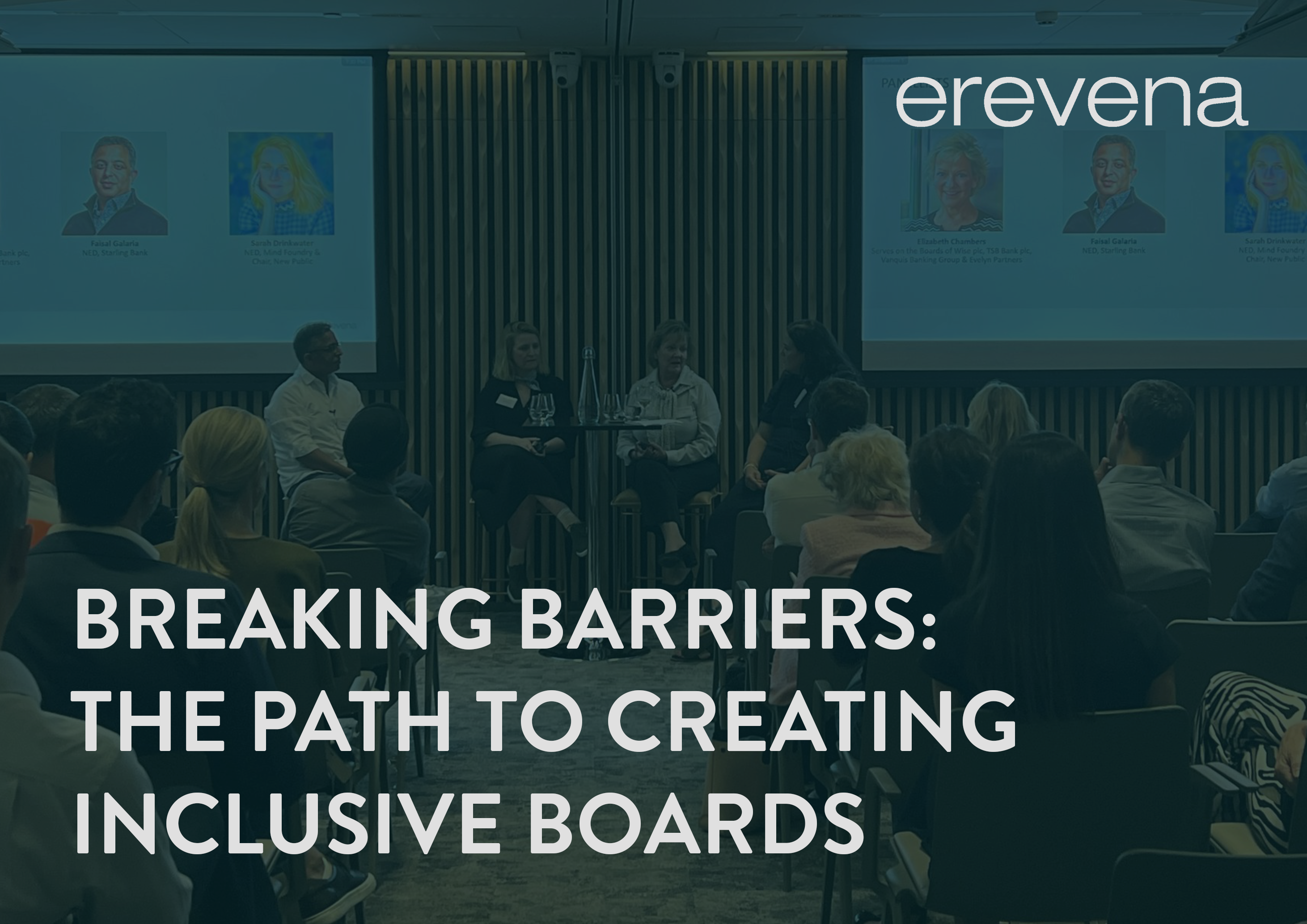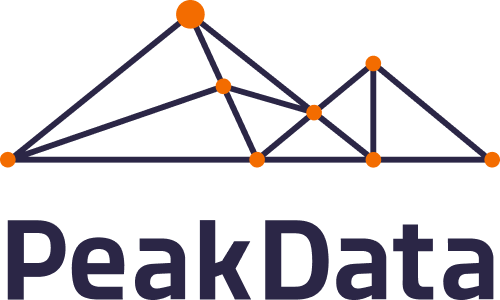Erevena’s Boardroom Remuneration study for small cap businesses always provides an interesting lens on boardroom trends and the evolving role of Chairs and Non-Executive Directors. This year we also introduced a focus on Boardroom diversity, culminating in a panel discussion about our panellist’s experience of diversity in the Boardroom.
Our five panellists, Shefali Roy (COO & CCO TrueLayer, Board Member Photoworks, Board Member Ada’s List, TEDx speaker), Martin Stead (CEO Nutmeg, Financial Times Top 100 LGBT Executive), Rebecca Miskin (Non-Executive Director Centaur Media Plc, Executive Advisor), Ian McCaig (Board Member Seedrs, Chairman Festicket, Chair of Operating Committee at M-KOPA Solar), and Sabrina Castiglione (CFO Tessian, Chair of the WISE YP Board), drew upon their vast experience to engage in what was a thoughtful and compelling discussion surrounding boardroom diversity.
The discussion centred around a few key questions:
Why is diversity important?
In recent years, there has been a significant increase in the amount of conversation around the topic of diversity. However, it is not always connected to impact on business outcomes. It is therefore important to address the initial question of why diversity is important.
Beginning the discussion, Ian expressed that diversity’s importance is rooted in the value it adds to a company. A Board comprised of people from the same background, all of whom think similarly, results in missed opportunities and narrow-minded outcomes. Drawing on Ian’s point, Shefali stated that a diverse team fundamentally changes the way a product is built through allowing a diverse range of perspectives. Above all, as Martin drew attention to, focusing on diversity allows a business to access the best and widest range of talent. It should therefore be considered essential and something a company must take accountability for.
It is also critical for an employee to be able to look up to the Board or company leaders and feel encouraged to strive to be there. As Rebecca pointed out, this is done most effectively when they recognise something of themselves there. Martin also added that alongside better productivity, having a diverse and inclusive Board is representative of the customers that companies serve.
Where does diversity start?
Sabrina aptly drew attention to the disparity between acknowledging the need for diversity and the actions being implemented to improve inclusion. Particularly in growth businesses, where the pressing issue can often be survival, the need to grow rapidly understandably drives pragmatic rather than ideal decisions, causing a focus on diversity to sometimes be deprioritized.
“There is a real tension between what is considered important and what is considered urgent.”
– Sabrina Castiglione
Recognising diversity as a problem is easier than recognising it as your problem. This is demonstrated clearly in the fact that despite 48% of surveyed Boards having no women and 61% having no BAME members, 41% of these Boards are taking no action to improve diversity. Reflecting on these statistics, Ian concluded that people are not thinking enough about diversity.
“People don’t try hard enough because people equate change with risk.”
– Ian McCaig
It is this attitude which has to change before the problem can be solved. For Martin, a company’s culture comes from the top of the company – the Board. Having a diverse Board should be a priority to promote a diverse and inclusive working environment. Ian and Martin have both experienced people being attracted to companies when they clearly see diversity higher up in the business. Whilst having diversity at the Board table isn’t necessarily essential to having a more diverse culture, the correlation between a consciousness about diversity at the highest levels of a company often drives a point of accountability into the business. If the Board cares about diversity, and expects reporting on diversity, the company will naturally drive towards those KPIs.
The panellists agreed that the root of impacting diversity also originates in the recruitment process. Within early-stage companies, there is a real opportunity to change the game from the ground-up. For TrueLayer, gender parity has been viewed as a priority since the origins of the company. With this established at base level, the company’s gender diversity has continued with its growth. Furthermore, whilst the importance of Board diversity is not to be undermined, for Rebecca one of the biggest issues is diverse candidates coming through for Board roles. Something must therefore be done about diversity and inclusion below Board level.
Alongside having a diverse short list of candidates, companies should strive for a diverse recruitment panel. In order to implement change, a more inclusive and diverse range of opinions is necessary. Recruitment alone however is not enough to guarantee diverse candidates progressing through a company. An inclusive workplace is required to support and solidify these initiatives.
Who do you see as responsible for diversity and inclusion?
The panel agreed that diversity needs to be viewed as more than simply ticking boxes and should be dealt with in a sincere way. It is also vital to recognise that an inclusive business culture is as important as diversity.
“Diversity is only part of the challenge. Inclusion is the biggest objective.”
– Rebecca Miskin
As Sabrina argued, attracting diverse candidates is only the first step for a business striving to achieve diversity. If an environment is not inclusive, people will not want to work there. It can feel like a hard commitment and change to make; however, it is necessary in order to allow employees to grow and progress through a company.
Furthermore, as Sabrina recognised, a lot of the time companies rely on someone stepping up as a champion of diversity and inclusion. However, it should be something that the CEO prioritises in order to ensure change is implemented. In addition to the CEO, Ian acknowledged that the Board is also of high importance. It is their responsibility to demand that areas of diversity are looked at and reported on.
For Shefali, there is a disparity between smaller companies at seed, A, B, and C-stage and larger public companies which can make prioritising diversity a challenge.
“With smaller companies, the priority is to survive and there can be a tendency to focus on that instead of diversity.”
– Shefali Roy
Within the companies surveyed, those with 11-50 people had only 14% of their Boards made up of women. Alternatively, companies with over 1000 people had 27% of their Boards comprised of women, thus reiterating Shefali’s point.
Smaller companies are often also unable to affect the diversity make-up of the majority of their Board. Many raise capital from the venture community who often have poor levels of diversity in their investor ranks. With so few pence in the pound also going to back female founders, the inherently masculine nature of small cap boards prevails. However, Ian warned that a misalignment of values rarely ends well. It may often seem that there are not many options for capital raising but it is important for smaller companies to consider diversity when evaluating capital options.
Drawing on this, Sabrina acknowledged that venture capitalists consequently have more power to make change than an entrepreneur trying to grow a business. What is currently a vicious cycle could potentially become virtuous if VCs choose to invest into diverse companies or diversify their own businesses more aggressively.
“The people invested in today are the investors of tomorrow.”
– Sabrina Castiglione
What practical advice can you give?
Shefali and Ian advocated for the importance of internal training and development. This should be focused in the right way to develop people so that they can progress effectively through the company with less unconscious bias. It additionally suggests personal development to be a priority for the company and this in turn promotes an inclusive working environment.
Both Rebecca and Martin emphasised the benefits of having people stay and develop in an organisation. It is therefore beneficial for companies to be flexible, allowing employees to work effectively in a way that suits them. For example, allowing people to work partially from home can often increase productivity, particularly if they have a long commute or family to care for.
Furthermore, Shefali has experienced the benefits of mentorship, both for improving inclusivity and the development of employees.
For Ian, those in executive roles should be encouraged to take non-executive positions. There can be a reluctance within companies to encourage employees to accept non-executive roles but it is this which will ultimately drive change on boards and create more ‘board ready’ candidates.
Reflecting on her early comments regarding the urgency of diversity, Sabrina recommended carving out time and flagging it as a priority on the agenda. It can be hard when there are thousands of other things to do, but the longer it is left, the larger a problem it becomes.
Alongside attracting diverse candidates, it is also important to consider practicalities, such as equal pay. For Shefali, this is a matter of being thoughtful and continually conscientious that all employees are paid fairly. Sabrina referenced a study where the majority (89%) of people who believed they were underpaid were actually at market rates or above. There is therefore benefit in having a level of transparency around the framework and calculations used to set salaries. This allows people to feel reassured that they are being paid fairly.
As the discussion drew to a close, the final emphasis was on the younger generation. The panellists collectively agreed on having a huge sense of optimism for the younger generation. Consequently, companies should be encouraged to have younger people on the board who can deliver new perspectives and offer thinking outside the traditional boxes.
Conclusion
It is apparent that diversity is a prevailing issue that is frequently spoken about but less frequently tackled head on. There can be a tendency to absolve ourselves of responsibility. However, it is only by collectively implementing actions of change that a difference will be made.
Mostly importantly, it must be recognised that diversity extends beyond simply hiring diverse candidates. Creating a working culture that is inclusive to all should be a priority for Boards and management teams moving forward.
“None of us like to think we have an unconscious bias, but we do, and we need to actively work against it.”
– Martin Stead
Share this article:













